Much of the change in the way mothers and fathers spend their time has been driven by women’s growing presence in the workplace. And the pressures of modern parenthood are inextricably linked to the competing demands of work and home life that face both mothers and fathers today.
Although they have reached near parity with men in terms of their representation in the labor force, many women, especially mothers, still wrestle with what their “ideal” situation would be—working or not working, working full time vs. part time. Since 2007, there has been a significant spike in the share of mothers who say working full time would be ideal for them. This chapter will explore mothers’ changing views about work and what the public believes is best for children. It will also look at what mothers and fathers value most in a job.
Women in the Labor Force
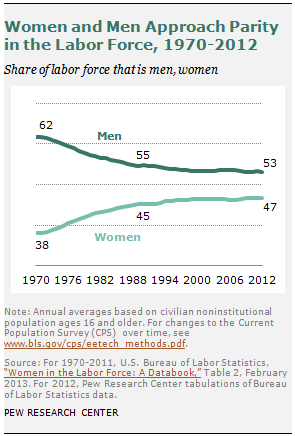
Today women make up almost half (47%) of the U.S. labor force, up from 38% in 1970. Women’s share in the labor force rose steadily from 1970 to about 1990. It leveled off in the mid-1990s and has remained relatively stable since then.
In 2012, 68% of women ages 16 to 64 were in the labor force—that is, they were either employed full or part time or unemployed but looking for work. This compares with 79% of working-age men.
Among mothers with children—especially those with school-aged children—a slightly higher share is in the labor force. Among all mothers with children younger than 18, 71% are labor force participants. That share is higher still for mothers with children ages 6 to 17 (76%) but somewhat lower for those with very young children (65%).
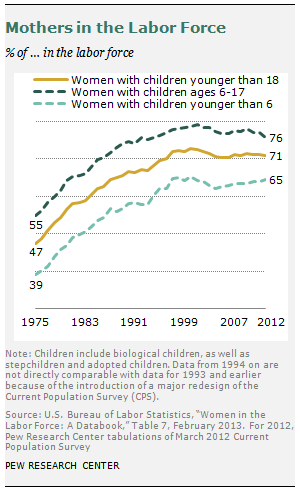
The share of mothers in the labor force increased sharply from 1975 to 2000. Only 39% of women with children under the age of six were in the labor force in 1975; by 2000 the share had risen to 65%.
While a plurality of today’s mothers (47%) say their ideal situation would be to work part time, in reality most working mothers are employed full time. Among all mothers with children younger than 18 in 2012, 51% had worked full time in the previous year, 19% worked part time and 29% did not work at all.3
Mothers’ Views about Work Change with the Times
Mothers’ views about whether and how much they would like to work have changed significantly in the recent years. Compared with 2007, more mothers now say working full time would be ideal for them, and significantly fewer say not working at all would be ideal.
However, this change may be more a reaction to outside forces than a natural evolution of views. The Pew Research Center has measured this on three separate occasions over the past 15 years, and at each point in time, women have expressed a different set of attitudes. Between 1997 and 2007, the share of mothers with children younger than 18 who said their ideal situation was to work full time fell significantly, from 30% to 20%.4 Over that same 10-year period, the share of mothers who said they would prefer to work part time went from 44% to 50% (not a statistically significant change). And the share saying their ideal situation would be to not work at all stayed largely unchanged (26% in 1997 and 29% in 2007).
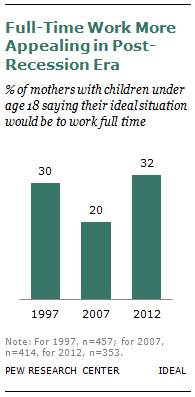
Between 2007 and 2012, mothers’ views about full-time work moved in the opposite direction. The share saying that full-time work would be ideal for them rose sharply, from 20% to 32%, while the share saying they would prefer not to work at all fell from 29% to 20%. The share opting for part-time work did not change significantly (50% in 2007 and 47% in 2012).
There was no clear explanation for the change in attitudes from 1997 to 2007, but the more recent shift occurred during one of the most difficult economic periods in recent history. The Great Recession, which officially started in December 2007 and ended in June 2009, had an impact on mothers and fathers alike. A Pew Research survey conducted in May 2010 found that among all adults in the labor force, more than half (55%) had experienced some type of work-related hardship during the recession—a spell of unemployment, a cut in pay, a reduction in hours or a forced move to part-time work. These experiences may have helped to reshape mothers’ views toward work.5
More Working Mothers Now Prefer Full-Time Work
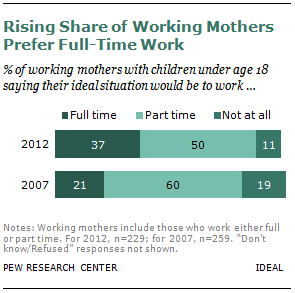
The recent shift toward a preference for full-time work has been more pronounced among working mothers themselves than among those who are not employed. Fully 37% of today’s working mothers say their ideal situation would be to work full time, up from 21% of working mothers in 2007. (Among non-working mothers, the increase from 16% to 22% is not statistically significant.)
Only 11% of working mothers say their ideal situation would be not to work at all, down from 19% in 2007. Part-time work remains the most appealing option for working mothers; 50% now say working part time would be ideal for them, down marginally from 60% in 2007.
Among mothers who do not work outside the home, in 2007, roughly half (48%) said not working was their ideal situation. Today only 36% of these mothers say the same. The share saying they would prefer to work either full or part time has increased slightly over the same period (from 49% in 2007 to 63% now).
For their part, fathers prefer full-time work. Fully 75% of fathers with children under age 18 say working full time is ideal for them. Some 15% say working part time would be ideal, and
10% say they would prefer not to work at all. In general, fathers’ views about what is ideal for them have not changed significantly in recent years. In 2007, 72% of fathers with children under age 18 said working full time would be ideal for them, 12% said they would like to work part time and 16% said they would prefer not to work at all.
Tough Economic Times and Changing Attitudes about Work
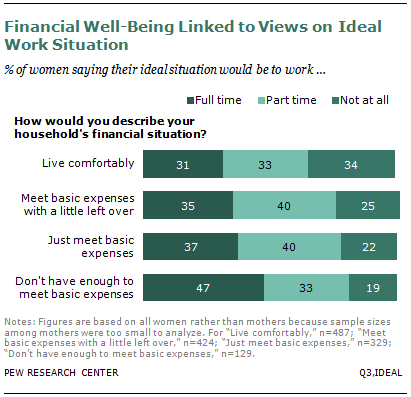
The new Pew Research survey finds a strong correlation between financial well-being and views about the ideal work situation, particularly among women. Respondents were asked to describe their household’s financial situation, and among women who say they “don’t even have enough to meet basic expenses,” nearly half (47%) say the ideal situation for them is to work full time.
By contrast, among women who say they “live comfortably” only 31% say working full time is their ideal situation. Fully one-third (34%) of this group says not working at all would be ideal for them. Women who say they can meet their basic expenses but do not live comfortably are more evenly split between whether working full time or working part time would be ideal for them.
Similarly, income is tied to mothers’ views about what is ideal for them. Some 40% of mothers with annual family incomes of less than $50,000 say full-time work would be best for them, compared with 25% of mothers with incomes of $50,000 or higher.
Mothers and the Marriage Gap
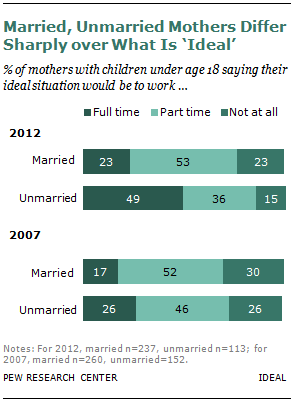
Marital status is also strongly related to views about the ideal work situation, and the gap in views between married and unmarried mothers has widened significantly in recent years. For married mothers with children under age 18, working part time is the most desirable situation—53% say this would be ideal for them. About one-in-four married mothers (23%) say their ideal situation would be to work full time, not significantly different from the share saying this in 2007 (17%).
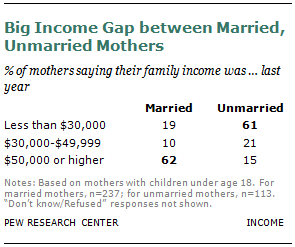
Among unmarried mothers, about half (49%) say working full time would be their ideal. This is up dramatically from 26% who said the same in 2007. About one-third (36%) of unmarried moms say they would ideally like to work part time, and only 15% say what would be ideal for them would be not working at all.
As a group, unmarried mothers find themselves in a much different financial situation than married mothers. Only 15% of unmarried mothers with children younger than 18 say their family income was $50,000 or higher last year. By contrast, among married mothers, 62% report having an annual family income of $50,000 or higher. Among unmarried mothers, fully 61% say their income was below $30,000 last year. This compares with 19% among married mothers. This suggests that choosing full-time work may be more of an economic necessity than a lifestyle choice, especially for unmarried mothers.
According to data from the U.S. Census Bureau, the share of single mothers has been steadily rising over the past 50 years. In 1960, only 8% of mothers with children in their custody were single mothers. Today, about three-in-ten (31%) mothers are unmarried.6
What’s Ideal for Children?
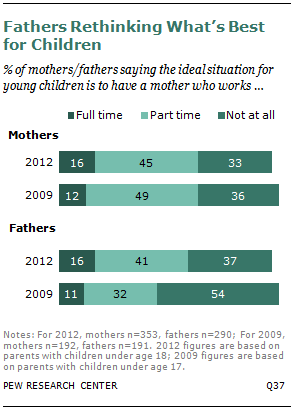
There remains somewhat of a disconnect between what mothers describe as their ideal work situation and what society says is ideal for children. While 32% of mothers with children under age 18 say they would prefer to work full time, only 16% of all adults say having a mother who works full time is ideal for a young child. A plurality of adults (42%) say having a mother who works part time is ideal for a young child, and one-third say having a mother who doesn’t work at all is ideal. The public’s views on this have changed somewhat since 2009, when 43% of all adults said the ideal situation for a young child was to have a mother who doesn’t work at all.
Mothers and fathers are largely in agreement on what is best for young children. Mothers’ views about this have remained relatively consistent over the past few years, while fathers’ attitudes have changed. In 2009, 54% of fathers with children under age 17 said the ideal situation for young children was to have a mother who did not work at all. Today only 37% of fathers with children under age 18 say this—a drop of 17 percentage points.
Mothers’ views about what is best for children differ widely depending on their own circumstances. Mothers who are employed full time are much more likely than mothers who do not work to say having a working mother is ideal for a young child (75% vs. 44%). Even so, most full-time working mothers don’t endorse their own situation. Only 22% say having a mother who works full time is best for a young child, while 53% say having a mother who works part time is ideal. About one-in-five (19%) mothers who work full time say having a mother who doesn’t work at all is best for a child.
Mothers who don’t work have a much different view. Fully half (51%) say having a mother who stays home is ideal for a young child. Only 11% say having a full-time working mother is ideal, and 32% say having a mother who works part time is the best situation for a young child.
Views on What’s Best for Children Differ by Race, Age
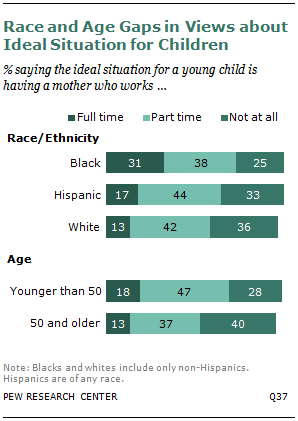
Among all adults, blacks (31%) are much more likely than whites (13%) to say that the ideal situation for young children is to have a mother who works full time. Only one-in-four blacks say it’s best for young children if their mother does not work at all outside the home; this compares with 36% of whites. The gap on this issue between black men and white men is particularly large. While 40% of white men say the ideal situation for a young child is to have a mother who stays home, only 21% of black men agree. The views of Hispanics are similar to those of whites.
There is also an age gap in views about what’s best for children. Adults under age 50 are more likely than those ages 50 and older to say having a working mother is the best thing for a young child. Some 18% of those under age 50 say having a mother who works full time is the ideal situation for a young child, and an additional 47% say having a mother who works part time is ideal.
By contrast, among those ages 50 and older, only 13% say having a full-time working mother is ideal for children, and 37% say having a mother who works part time would be best. Fully 40% of those ages 50 and older say the ideal situation for a young child is to have a mother who doesn’t work at all outside the home. Only 28% of adults under age 50 agree. The age differences are more pronounced among men than among women.
What’s Ideal for Mothers and Fathers with Young Children?
Survey respondents were also asked what the ideal situation is for mothers and fathers with young children. Among all adults, only 12% say it’s best for mothers of young children to work full time. A 47% plurality say working part time is the ideal situation for mothers of young children, and one-third say it’s best if these mothers not work at all outside the home.
The public has much different views about what is best for fathers of young children. Fully seven-in-ten adults say the ideal situation for men with young children is to work full time. One-in-five endorse part-time work for fathers of young children, and only 4% say the ideal situation for these dads would be not to work at all.
Fathers themselves are bigger proponents than mothers of full-time work for parents with young children. Among fathers with children under age 18, 17% say the ideal situation for mothers of young children is to work full time. Only 7% of mothers agree with this. When it comes to what’s ideal for fathers, there is somewhat more agreement: 75% of fathers say the ideal situation for fathers of young children is to work full time; 66% of mothers agree.
Mothers, Fathers and Work Life
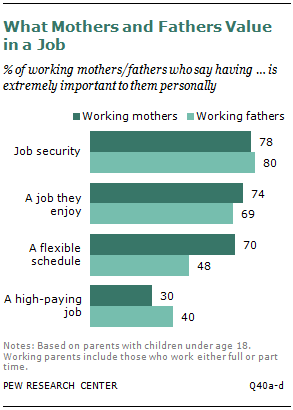
When it comes to their work lives, mothers and fathers place a great deal of importance on job security and personal fulfillment. Among working parents with children under age 18, roughly equal shares of mothers (78%) and fathers (80%) say having job security is extremely important to them. And they value nearly as much having a job they enjoy: 74% of working mothers and 69% of working fathers say this is extremely important to them.
Having a flexible work schedule is much more important to working mothers than it is to working fathers. Fully seven-in-ten working mothers with children under age 18 say having a flexible schedule is extremely important to them. Only about half (48%) of working fathers place the same level of importance on this.
There is a large gap between parents and non-parents in the value each places on having a flexible work schedule. Among working women with no children under age 18, only 43% say having a flexible work schedule is extremely important to them (vs. 70% of working mothers). And among working men with no minor children, 36% say this is extremely important (vs. 48% of working fathers).
Mothers and fathers differ in the importance they place on having a high-paying job. Four-in-ten working fathers say having a high-paying job is extremely important to them, compared with three-in-ten working mothers.
Among working mothers, there is a significant gap between those who are married and unmarried in terms of the value they place on having a high-paying job. Only 26% of those who are married say this is extremely important to them personally, while 39% of those who are unmarried say having a high-paying job is extremely important.
Job Satisfaction
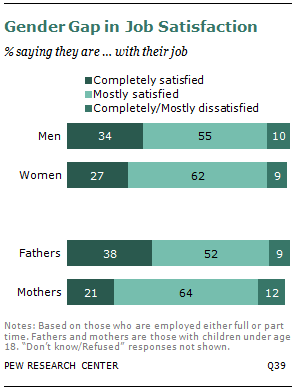
While not all women agree about what their own ideal work situation would be, those who do work are generally satisfied with their job. Overall, 27% of women who work at least part time say they are completely satisfied with their job, and an additional 62% are mostly satisfied. Only about one-in-ten are completely (3%) or mostly (6%) dissatisfied with their job.
Women who work part time are no more or less satisfied with their jobs than those who work full time.
Working mothers are less satisfied with their jobs than are working women who do not have minor children. Among all working mothers with children under age 18, 21% say they are completely satisfied with their job; this compares with 32% of working women without children under age 18.
Men are more likely than women to say they are completely satisfied with their job (34% vs. 27%). And the gap between mothers and fathers is even wider. Among working fathers with children under age 18, 38% say they are completely satisfied with their job (only 21% of working mothers say the same).




